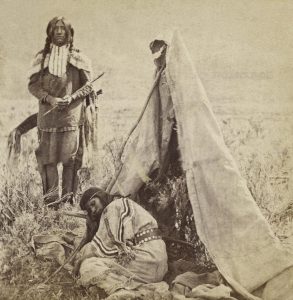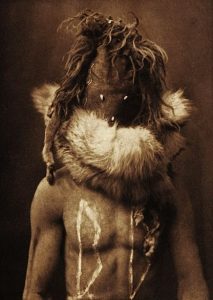
A Native American Medicine Man standing beside a sick woman, c. 1870. Photographed by O.C. Smith (American, active 1860s – 1870s).
In almost every Native American tribe, there is a medicine man or healer, as seen in the picture above. These men, and occasionally women, had to go “beyond human power” to use their herbs and chants to heal ailing tribesmen. A medicine man gained his power to heal through dreams, visions, and even during the song, as discovered in class while looking through many primary sources. During visions and encounters with the Great Spirit, healers were told how to heal ailments and advised on which herbs, roots and plants to use, and which to avoid. To aide their power, healers often lived in quiet seclusion to be in tune with nature its power sometimes giving them the name “forest folk”.1

A traditional medicine mask used to scare off evil spirits and disease in tribe members. https://indianspictures.blogspot.com/search/label/Navajo%20indians
Ely S. Parker, born in 1828, was from the Iroquois tribe and in newspapers, recounts the practices of the medicine man through public and private ceremonies. Native American medicine men treated the sick and ailing in public ceremonies followed by a private meeting. The public ceremony was attended by tribesman of high power and influence and took place over several days. During those public and private healing sessions, the medicine man may have told narratives, chanted, and sing. A “sacred song” is chanted only by one medicine man. If anyone else chants the “sacred song,” it is expected that evil events will follow.2 To further aide him, he may have used tobacco pouches and the herb of choice sent to him by the Great Spirit. There are times when the the medicine man is not able to heal the sick, but this is viewed as the will of the “Great Spirit” who is asked to “guide the red man and choose for his best, always.”
Most songs were accompanied by a regular drumbeat, dubbed as the heartbeat of the Earth, to help calm and relax the sick. Additionally, the drumbeat expanded the mind of the medicine man to the awareness of self and spirit. Other instruments like the rattle, shook away disease, and bells borrowed from Christianity invoked God’s healing power.3 It is told that “he who holds the medicine has time to die.” That is, they can choose their successor because their death is never sudden and “has time to die.” This background of the medicine men’s rituals which were alien and exotic to foreigners such as John Smith helps shed a light on what outside visitors encountered.
1 Hofmann, Charles. American Indians Sing New York: John Day Co., 1967. 46
div id=”sdfootnote1″>
2 Ely Samuel Parker scrapbooks: Vol 11, 1828-1894, © The Newberry Library, 96 http://www.aihc.amdigital.co.uk/Documents/Images/Ayer_Modern_MS_Parker_VL11/55?searchId=c2aa61ad-bbdf-48e6-a160-bba150f8d14e#VisualMaterials

This is a solid report on the role of the medicine man in certain Native American societies, and I appreciate the visual aids that you include. But I’m not sure what primary source it is you’re featuring. Ken Cohen’s article is a secondary source, summarizing knowledge about a variety of Native American medicinal practices. Charles Hofmann’s book might be primary for understanding late-20th-century ideas about Native American music, but that’s less relevant to what we’ve been talking about in class. I’d like to see you go back and find a primary source that addresses the role of the medicine man and his musicking, and adjust your post accordingly.